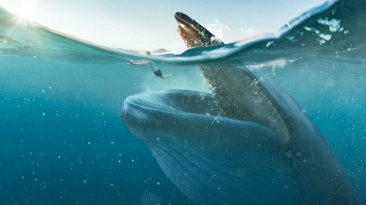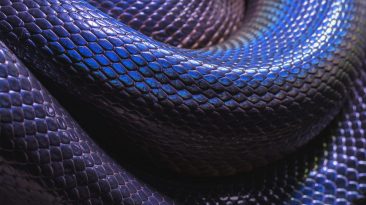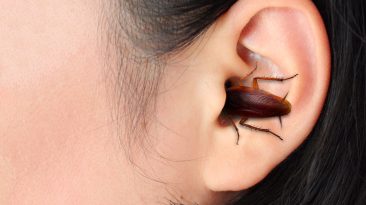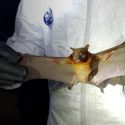Have you ever heard of Medusa? The snake-haired greek monster who turns people to stone with a single glance? Well, she might just be a myth, but there is an area so deadly that it could actually turn you to stone. The infamous Lake Natron.
What makes Lake Natron’s water so dangerous? What kind of creatures live there? Could you survive if you fell in?
Before we take the plunge, we’d better take a look at what Lake Natron is made of. Much like the Dead Sea, this Tanzanian lake doesn’t run off into any oceans or rivers. This allows it to soak up all that salty desert rain. Mmm, soupy. Yet what makes it especially lethal, is its close proximity to the active volcano, Ol Doinyo Lengai.
The volcano spews a rare kind of lava rich in sodium (Na) and potassium carbonate (K2CO3), called Natrocarbonatite, or Natron for short. Releasing into the water, this mix of sodium carbonate and sodium bicarbonate were key ingredients once used in Egyptian mummification, creating the perfect preservative in lake form. The whole chemical composition is extremely alkaline, with pH levels of 10.5 close to matching ammonia (NH3). This gives the lake its rosy hue. Any birds that happen to take a dive and don’t make it out become calcified in a hardened, stonelike husk. Talk about killing two birds with one stone!
In 2013, wildlife photographer Nick Brandt was one of the first to document this phenomenon. He discovered several stone birds and other unlucky animals in the dry season when the water had receded. He theorized, since the lake is so mirror-like and reflective, the birds must have flown right into it. As if it was a big glass door. Kind of like that one time in the office. Well, never mind. Despite so many birds dying in Lake Natron, there is a particular species flourishing. Turns out, the lake’s toxic waters provide a safe haven from predators, making it perfect flamingo flocking grounds.
So if flamingoes can handle it, couldn’t we?
Well, it’s not that simple unfortunately. Flamingoes thrive in salty lakes because of their tough skin and scaly legs which prevent burns. They can drink the freshwater from nearby springs or geysers at the edges of the lake, and if they’re desperate enough, they can even filter saltwater with special glands in their nasal cavities. And to top it off, their strong stomachs allow them to feed on the toxic algae found throughout the lake. This makes Lake Natron the perfect spot to raise and protect their young.
So, let’s say we tried to live like a flamingo and decided to take a dip? Depending on the time of year, the water can be up to 60 degrees Celsius (140 Fahrenheit), which is hot enough to cause third-degree burns in five seconds or less. Also, I wouldn’t plan on doing any fancy dives or cannonballs, as its shallowness is also chock full of sharp, salty structures.
You wouldn’t be turned to stone instantly, but if you happened to drown and stay submerged, your entire body would harden and be preserved. If people found you hundreds of years later, you might still have your hair and organs intact. Yep, still looking spiffy after all those years! Like a mummy, Natron’s super high alkalinity stops the decomposition process.
Thankfully, this means you’d be safe from vultures or any other hungry scavengers looking for a snack. If you waded into the lake at a time when the water temperature was lower, it could feel more like a hot tub. But your eyes or any open wounds would sting like crazy because of all the salt. I’d strap on some goggles if I were you!
In 2007, another kind of bird flew straight into this chemical cocktail. A group of wildlife videographers plunged Lake Natron’s toxicity when their helicopter crashed. The pilot suffered a broken leg, and another passenger had a broken hip. Incredibly, one of the passengers managed to struggle to shore and alerted some of the Masai tribespeople nearby. They quickly built stretchers and carried the injured to land in the nick of time.
Even though you could survive Lake Natron’s waters, I’d stick to a swimming pool if I were you. As for our flamingo friends, this just goes to show how the harshest environments can be a sanctuary for some animals. But if you’re craving something even more extreme, how about surviving a limnic eruption on your next swim? Think you could handle it?
Subscribe to What-If on YouTube or follow the show on Facebook Watch.
Sources
- “This Alkaline African Lake Turns Animals Into Stone”. @JosephStromberg, Follow. 2013. Smithsonian Magazine.
- “Acids, Bases, & The Ph Scale”. 2020. Science Buddies.
- “The Lost World of Socotra Archipelago”. 2020. discovery.com.
- “HOT WATER SAFETY”. 2020. Cash Acme Plumbing Products | Thermostatic Regulating Pressure Valves.
- “The Facts About Ammonia”. 2020. health.ny.gov.
- “Lake That Turns Animals To Stone? Not Quite”. livescience.com.




























I feel obliged to point out that Lake Natron is situated in the African nation of Tanzania, rather the Australian state of Tasmania. Otherwise, an interesting article.
[…] “What If You Jumped Into Lake Natron? | What If Show”. 2020. What If Show. […]